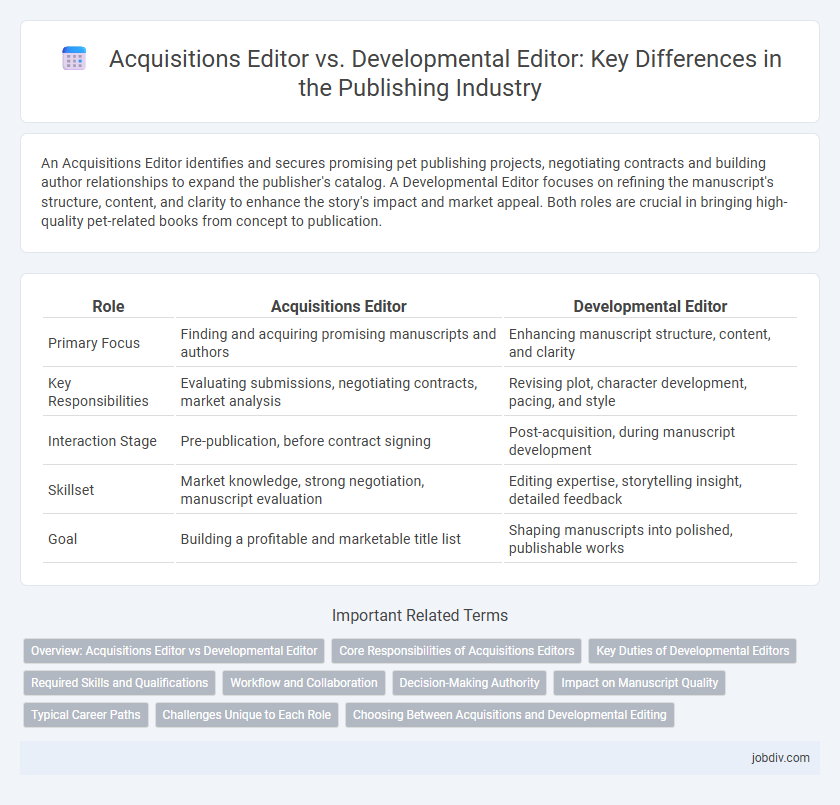An Acquisitions Editor identifies and secures promising pet publishing projects, negotiating contracts and building author relationships to expand the publisher's catalog. A Developmental Editor focuses on refining the manuscript's structure, content, and clarity to enhance the story's impact and market appeal. Both roles are crucial in bringing high-quality pet-related books from concept to publication.
Table of Comparison
| Role | Acquisitions Editor | Developmental Editor |
|---|---|---|
| Primary Focus | Finding and acquiring promising manuscripts and authors | Enhancing manuscript structure, content, and clarity |
| Key Responsibilities | Evaluating submissions, negotiating contracts, market analysis | Revising plot, character development, pacing, and style |
| Interaction Stage | Pre-publication, before contract signing | Post-acquisition, during manuscript development |
| Skillset | Market knowledge, strong negotiation, manuscript evaluation | Editing expertise, storytelling insight, detailed feedback |
| Goal | Building a profitable and marketable title list | Shaping manuscripts into polished, publishable works |
Overview: Acquisitions Editor vs Developmental Editor
Acquisitions editors focus on identifying and securing new manuscripts that align with the publisher's market strategy, negotiating contracts, and building relationships with authors and agents. Developmental editors work closely with authors to shape the manuscript's structure, content, and style, ensuring the work meets editorial standards and audience expectations before production. Both roles are crucial in the publishing process, with acquisitions editors driving content acquisition and developmental editors enhancing manuscript quality.
Core Responsibilities of Acquisitions Editors
Acquisitions editors primarily focus on identifying and securing promising manuscripts by evaluating proposals, negotiating contracts, and cultivating author relationships to expand the publisher's portfolio. They analyze market trends and reader demands to determine which content aligns with the company's strategic goals. Developmental editors, in contrast, concentrate on shaping the manuscript's structure and content after acquisition, guiding authors through revisions to enhance clarity and coherence.
Key Duties of Developmental Editors
Developmental editors play a crucial role in shaping a manuscript's content, structure, and overall narrative to ensure clarity, coherence, and market appeal. They collaborate closely with authors to refine plotlines, strengthen character development, and enhance pacing, providing in-depth feedback to elevate the work's quality. Unlike acquisitions editors who focus on selecting and acquiring manuscripts, developmental editors concentrate on the manuscript's artistic and structural improvement before the editing and production stages.
Required Skills and Qualifications
Acquisitions editors require strong market analysis, negotiation skills, and a deep understanding of publishing trends to identify and secure promising manuscripts. Developmental editors must possess excellent communication, storytelling insight, and editorial expertise to shape and enhance manuscript content effectively. Both roles demand a thorough knowledge of the publishing process, but acquisitions editors prioritize deal-making abilities, while developmental editors focus on content refinement and author collaboration.
Workflow and Collaboration
Acquisitions editors manage the initial manuscript selection and contract negotiations, working closely with authors to secure promising projects, while developmental editors focus on shaping the content's structure and storytelling during the editing process. Workflow coordination between these roles ensures seamless transitions from content acquisition to manuscript development, optimizing timelines and enhancing author collaboration. Effective collaboration between acquisitions and developmental editors streamlines the publishing pipeline, improving overall project quality and successful market delivery.
Decision-Making Authority
An Acquisitions Editor holds primary decision-making authority in selecting manuscripts for publication, assessing market potential and aligning acquisitions with the publisher's strategic goals. In contrast, a Developmental Editor focuses on shaping the content and structure of a manuscript post-acquisition, providing detailed guidance to authors without making final publication decisions. The Acquisitions Editor drives the initial greenlight process, while the Developmental Editor refines the manuscript to enhance its overall quality and market readiness.
Impact on Manuscript Quality
Acquisitions editors primarily assess manuscripts for market potential and strategic fit, influencing the selection process that determines the initial quality baseline of published works. Developmental editors directly enhance manuscript quality by providing in-depth feedback on structure, content, and coherence, ensuring the narrative aligns with audience expectations. The combined impact of acquisitions and developmental editors ensures both the commercial viability and literary excellence of the final publication.
Typical Career Paths
Acquisitions editors commonly begin their careers as editorial assistants or marketing coordinators, advancing by developing strong industry connections and a keen sense for market trends to secure promising manuscripts. Developmental editors often start as editorial assistants or copy editors, gaining expertise in structuring and refining content before moving into roles focused on guiding authors through significant content revisions. Both roles require a deep understanding of the publishing process, but acquisitions editors prioritize market viability while developmental editors focus on manuscript improvement and narrative coherence.
Challenges Unique to Each Role
Acquisitions editors face the challenge of identifying marketable manuscripts and securing profitable publishing rights under tight deadlines, often navigating complex contract negotiations and balancing author expectations with publisher goals. Developmental editors grapple with shaping raw manuscripts into cohesive, engaging narratives, requiring deep editorial insight and sensitivity to authorial voice while managing extensive revisions and maintaining consistency throughout the project. Both roles demand specialized skills in market analysis and editorial judgment, yet acquisitions editors prioritize deal-making and market trends, whereas developmental editors focus on content refinement and storytelling structure.
Choosing Between Acquisitions and Developmental Editing
Choosing between acquisitions and developmental editing depends on the primary stage of the publishing process you aim to influence; acquisitions editors focus on identifying and securing promising manuscripts to expand the publishing catalog, while developmental editors concentrate on enhancing the content, structure, and overall quality of an existing manuscript. Acquisitions editors rely heavily on market trends, author potential, and sales forecasts to guide acquisition decisions, whereas developmental editors work closely with authors to refine narrative flow, character development, and thematic coherence. Understanding these distinct roles helps publishers optimize manuscript potential and align editorial efforts with strategic business goals.
Acquisitions Editor vs Developmental Editor Infographic

 jobdiv.com
jobdiv.com